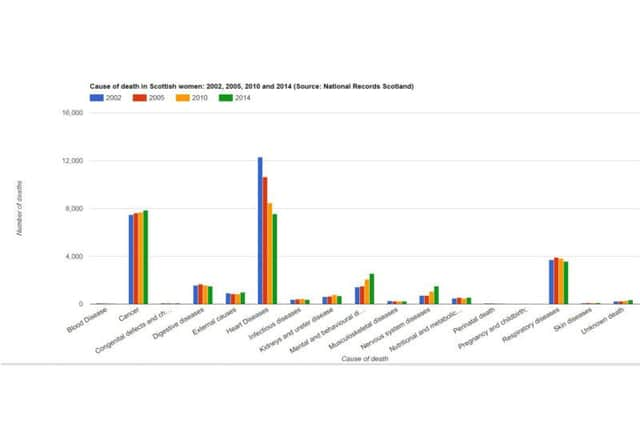What are you most likely to die from in Scotland?


Mortality may not be the cheeriest of subjects but understanding and identifying the causes of the 54,239 (National Records Scotland, 2014) deaths in Scotland each year enables governments and health bodies to channel resources into vital areas of the healthcare system.
National Records Scotland compiled cause of death data from 2002-2014 to determine exactly what are the biggest killers in Scotland.
In total 17 causes of death were identified:


Malignant Neoplasms- Various forms of cancer.
Advertisement
Hide AdAdvertisement
Hide AdInfectious diseases- e.g. Tuberculosis, HIV, viral hepatitis.
Diseases of the blood- e.g. Leukaemia, Hyperaemia.
Nutritional and metabolic diseases- e.g. Diabetes.


Mental and behavioural disorders- Includes mental disorders caused by alcohol and/or drugs.
Diseases of the nervous system- e.g. Meningitis.
Diseases of the circulatory system- e.g. Stroke, heart attack, various heart diseases.
Diseases of the respiratory system- e.g. Influenza, pneumonia, asthma
Diseases of the digestive system- e.g. Stomach ulcers, chronic liver disease.
Diseases of the skin- e.g. Lupus, melanoma
Diseases of Diseases of the musculoskeletal system and connective tissue- e.g. Rheumatoid arthritis and osteoarthrosis
Diseases of the genitourinary system- e,g kidney and ureter diseases.
Pregnancy or childbirth
Perinatal complications - deaths immediately before or after infant is born.
Advertisement
Hide AdAdvertisement
Hide AdCongenital malformations and chromosomal abnormalities - e.g Down syndrome, birth defects.
Abnormal clinical findings not elsewhere classified: Sudden infant death syndrome, unknown causes.
External causes- e.g. accidents, transport accidents, poisonings, assault, intentional self-harm.
Focusing specifically on the years 2002, 2005, 2010 and 2014 it can be seen that the traditional number one cause of death in Scotland, heart disease, slowly declined to be overtaken by cancer. This points to the success of several health programmes- such as the Heart Disease Improvement Plan (2009)- by successive Scottish Governments who have made fighting heart disease a clinical priority over the last 15 years.
Remarking on the figures, Dr Catherine Calderwood, Scotland’s Chief Medical Officer, said:
“The substantial decrease in heart disease deaths is one of the most encouraging health developments we’ve seen in recent years. There’s been significant investment in the field and a focus on prevention, improved treatment and better rehabilitation.
“Despite the reduction in mortality we must not be complacent. Last year we refreshed our Heart Disease Improvement Plan, setting out our key priorities. We should also remember that lifestyle factors, like smoking, diet and physical activity, can all have a significant impact on your chances of developing heart disease.
“An encouraging development has been a large decrease in the number of people dying by suicide. Dedicated work by professionals across the health, charity and social care sectors has contributed to a 17.8 per cent reduction in the Scottish suicide rate over the last ten years, and we will continue to work to reduce this yet further.”
Advertisement
Hide AdAdvertisement
Hide AdIn the male populations deaths from heart disease fell dramatically over the period from 10,405 (37.5 per cent) in 2002 to 7,464 (28.4 per cent) in 2014.
For women the decline in heart disease deaths is is even more significant as over the period from 2002- 2014 heart disease deaths plummeted from 12,283 (40.5 per cent) to 7,552 deaths (27 per cent).
In 2014 cancer is the most common cause of death for all Scots and deaths have slowly increased in men from 7,923 (28.6 per cent) in 2002 to 8311 (31.6 per cent) in 2014. For women the number of cancer deaths has fluctuated slightly over the time frame but has remained constant. The slight increase of cancer deaths may be reflect population increase as cancer detection methods have improved over the 12 year time period.
Future causes of concern for health leaders may be the rise in female deaths from mental and behavioural disorders which has risen from 1,425 in 2002 to 2,540 in 2014 and remains much higher than the male equivalent (1,412 in 2014).